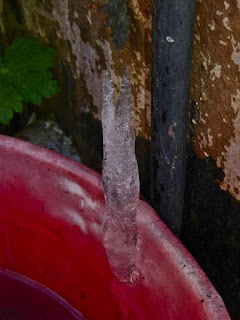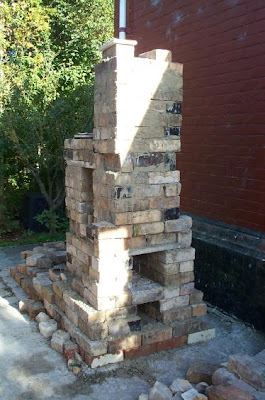Inspired by a 17th Century Watering Pot
 A visit to the Otago Museum can bring many unexpected surprises and delights, one was the discovery of a 17th Century earthenware watering pot in one of the display cases.
A visit to the Otago Museum can bring many unexpected surprises and delights, one was the discovery of a 17th Century earthenware watering pot in one of the display cases.The pot was robustly constructed and bore the unmistakable prints of the makers thumbs around where the potter had joined the spout to the body of the pot, and more thumb marks around the base. I loved the cheeky rather masculine spout and rose, and the more feminine curves of the body. I also admired the undisguised marks of the makers hands, and the toasting of the clay by the flames of the kiln that the pot was fired in.
I jotted down a sketch of the pot on a scrap of paper.
Sketching, no matter how shaky the attempt, is a really good way of looking closely at something, you see things that you would miss if you just simply took a photograph. When I looked carefully, I could see that there was a piece missing from the rim of the pot, I could see a line of indentations where something had once been joined, and I wondered what it might have been.
A search on the internet rewarded me with photographs of other delightful watering pots, some partially glazed with a splash of brown or green glaze, and others left plain. I found out straight away what the missing part was; namely a half circular slab of clay that projected upwards and made a low dam around the front half of the rim to stop water from slopping out as the watering pot was tilted forwards.

In all the examples that I saw, the dam was joined onto the rim with heavy, decorative thumb prints which explained the indentations in the rim of the museum's pot.
The form of the watering pot has most of the challenges that making a teapot has, but everything is more robustly constructed, and on a grand scale. Weight and balance are vitally important, and when throwing the body of the watering pot on the wheel it is important to move plenty of clay up high to form the neck of the pot and sturdy rim.
I set to work, and made several watering pots of my own out of earthenware clay on my kick wheel. I worked in the spirit of the watering pots that I had seen, rather than aiming for academic replication. I enjoyed playing with the proportions of the pot; one might have a fat belly and a short spout, another might be tall and thin.

The spout and rose are a bit of an engineering challenge. I tried two different approaches to constructing them. The first was making it in one piece, by throwing a short cylinder with no base, flaring out the sides, then pulling the top right in and sealing it to form a mushroom shape, then later adding the perforations. Whilst this method was fun to do, it was always hard to join the result to the pot, as it is almost impossible to support the inside of the pot whilst joining the spout on, due to the rotundity of the form and the relatively small neck.

The other method was to make spout and rose in two parts. The rose was made from a circular slab of clay that was domed slightly in the fingers and perforated with a needle. A short open ended cylinder was thrown on the wheel to form the spout. This was then joined onto the body of the watering pot, and the rose carefully luted onto the spout afterwards.
The second method made joining the spout to the pot easier, and also tended to produce the best results, because the perforations could be cleaned up from both sides which resulted in the pot pouring more effectively.
 The watering pots of long ago would have been fired in wood fired or coal fired kilns, and the earthenware clay is often chestnut brown and shiny from the contact with the flames. I also fire my pots in a wood fired kiln, and can get very similar results.
The watering pots of long ago would have been fired in wood fired or coal fired kilns, and the earthenware clay is often chestnut brown and shiny from the contact with the flames. I also fire my pots in a wood fired kiln, and can get very similar results.I try to position the pots where they will get some of the flame playing across them, so as to get maximum variation of colour. I use Brick Red clay, which is made by a Dunedin based firm, Southern Clays. Brick Red is clay as nature intended it, warm, honest, wholesome, and a pleasure to throw on the kick wheel. Brick Red fires to a strong, frost resistant body when fired to around 1100 degrees Centigrade in my wood fired kiln.
I realize that most of my pots are destined to be looked at rather than used, but after firing the pots, I do make sure that they work, and enjoyably test drive all of them.

Currently I have two large watering pots on exhibition at Gallery on Blueskin, which is a delightful new art gallery at Blueskin Bay, Waitati, about 15 minutes North of Dunedin. I also have some on display at the Stuart Street Potters Co-operative, Dunedin, of which I am a member.
The photos in this articles are of my own watering pots, and the sketch reproduced at the beginning of this is a detail of the drawing that I did at the Otago Museum of a 17th Century watering pot.
The Hunt Museum in Ireland have an online catalogue of ceramics, and have two watering pots you can view.
The catalogue numbers are HCM242 and HCM243.
http://test.huntmuseum.com/search_materials2.asp?mSearch=Ceramic


Comments
Thanks for your message on my blog. Ahhh New Zealand, brings back so many memories. We spent two months over there two years ago over December and January. We had the most fabulous time and would love to spend more time there in the future.
Lead glazes, yes we have to have them tested, allegedly every year in fact supposedly every batch you mix but at £70 a shot it's not cheap. Yes we have a lot of impported garden pots too, I rarely make any myself because I can't compete at all.
I don't think we made it to the Otago museum, we spent a few days in and around Dunedin and were shown around the clay mixing place down n teh harbour by a lovely chap, a potter who lived there at the time but I think is now in Australia.
I love your watering cans, they're great. I saw one in the Geffrye Museum in London last year.
Well best wishes,
I'll pop back soon,
Hannah
I met lots of potters over there, every day we stopped somewhere, my partner I think was getting a bit sick. I ended up sending 2 banana boxes full of pots home.
Your post office building is fabulous! I love it. We saw a builing I think that was an old fire station in a little town whose name can't just remember but it was near-ish to Mount Cook and was home to the worlds biggest knitted jumper. We were really keen on the building and still talk about it now.